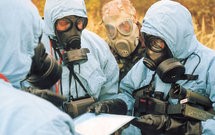 Nuclear Terrorism: Is the threat exaggerated?
Nuclear Terrorism: Is the threat exaggerated?
To play the Devil’s Advocate, it is not easy for unauthorized persons to acquire nuclear weapons or nuclear materials. Being crown jewels, they would be closely guarded by trusted cohorts. Even if they are subverted, the terrorists would have to overcome many other problems. Nuclear warheads are maintained in an unarmed state, and armed using electronic codes to ensure against accidental detonation.
These codes are kept secret by the ‘release authority’, obviously the Chief Executive in the nation. Further, in the case of India and Pakistan, nuclear cores are kept separate from the warheads and delivery vehicles; hence several steps have to be taken by different bodies to arm these weapons. Could all these hurdles be surmounted by a terrorist group?
Second, the problems faced to acquire nuclear materials is no less acute. Arrangements for their protection would be equally stringent. Should a terrorist group somehow gain access to weapons-usable nuclear materials, fashioning it into a deliverable nuclear weapon is not a trivial task.
Third, scenario builders have also visualized terrorist organizations gaining control over the nation, and accessing its military nuclear program and nuclear weapons. But the probability of all these events occurring must be rated low.
Nuclear Terrorism: Low Probability, but High Consequence
Despite the above, it is known that senior Pakistani scientists were in touch with Osama bin Laden. The CIA has highlighted al Qaeda’s general interest in weapons of mass destruction, including nuclear weapons. Al Qaeda’s branches and franchisees span the world. Moreover, several instances are known of missing nuclear materials being recovered. More alarmingly, nuclear materials have been found to be missing after they were recovered. Nuclear terrorism remains a discrete possibility; hence it should be designated a low probability high consequence event.
An imperative need consequently for the upcoming Netherlands Nuclear Security Summit to work towards establishing tighter international controls over nuclear materials; seeking greater transparency on national measures to enhance nuclear security; gaining more adherents for international agreements pertaining to the physical protection of nuclear materials; reducing the use of highly enriched uranium (HEU) and plutonium in national nuclear programs; registering the sources of radioactive materials that have extensive medical, educational and research applications; and strengthening the International Atomic Energy Agency (IAEA).
India and Nuclear Security
India’s contribution to these objectives has been considerable. It has joined the Convention on Physical Protection of Nuclear Materials, with its 2005 Amendment, and the International Convention for Suppression of Acts of Nuclear Terrorism. Further, India’s execution of UN Security Council Resolution 1540 (April 2004) has been exemplary; it casts a legally binding obligation on UN Member States to enforce effective measures against the proliferation of nuclear, chemical, and biological weapons (WMDs), and their delivery systems. It is especially intended to prevent terrorists and criminal organizations from obtaining the world’s most dangerous weapons. Towards this end States need to prohibit support to non-state actors seeking WMDs; adopt effective laws prohibiting activities involving the proliferation of WMDs to non-state actors; and, enforce effective measures to reduce the vulnerability of many legitimate activities to misuse and the proliferation of WMDs to non-state actors. These are essentially reactive measures.
Meeting the threat of nuclear terrorism proactively, however, requires a holistic program that can be framed within a matrix of four ‘Ds’ viz. Detection, Deterrence, Defense and Disaster Management. Clearly, Detection is an intelligence function, which requires high level attention, constant vigilance, technical competence and so on. The Deterrence option requires the country sheltering potential nuclear terrorists to be placed on notice, and threatened with condign punishment if any act of nuclear terrorism is perpetrated by its terrorists-in-residence. The problem here is that an organization like al Qaeda has branches in several countries. How can a deterrent relationship be established vis-à-vis such an organization? Defense against a nuclear attack is not feasible. hence it must be sought within the Defense and Deterrence matrix. Finally, Disaster Management in the post-attack aftermath must comprise a mix of immediate and longer-term relief, medical assistance, evacuation and rehabilitation measures. Special measures would be needed to deal with radiation casualties. There are many grey areas here such as the first responders getting incapacitated, and the sociological impact on affected societies, of which we have no knowledge or previous experience.
India, Nuclear Security and the NSS 2014
There is much that India can contribute to the Netherlands Security Summit. It could do more to meet the criticism that its nuclear program is opaque, and become more forthcoming about its emergency response systems It must also explain why it has not been able to fulfill its earlier commitments to establish an independent nuclear regulatory authority and a Centre of Excellence to train personnel in nuclear safety and security matters. It had contributed $ 1 million to strengthen the IAEA as the focal entity to ensure nuclear security. India could add to this contribution, and offer training facilities to IAEA personnel in its Centre of Excellence.
But, India should also suggest the extension of nuclear security measures by promoting pro-active measures to ensure nuclear security through a four ‘Ds’ program.
By Special Arrangement with Institute of Peace and Conflict Studies (http://www.ipcs.org)